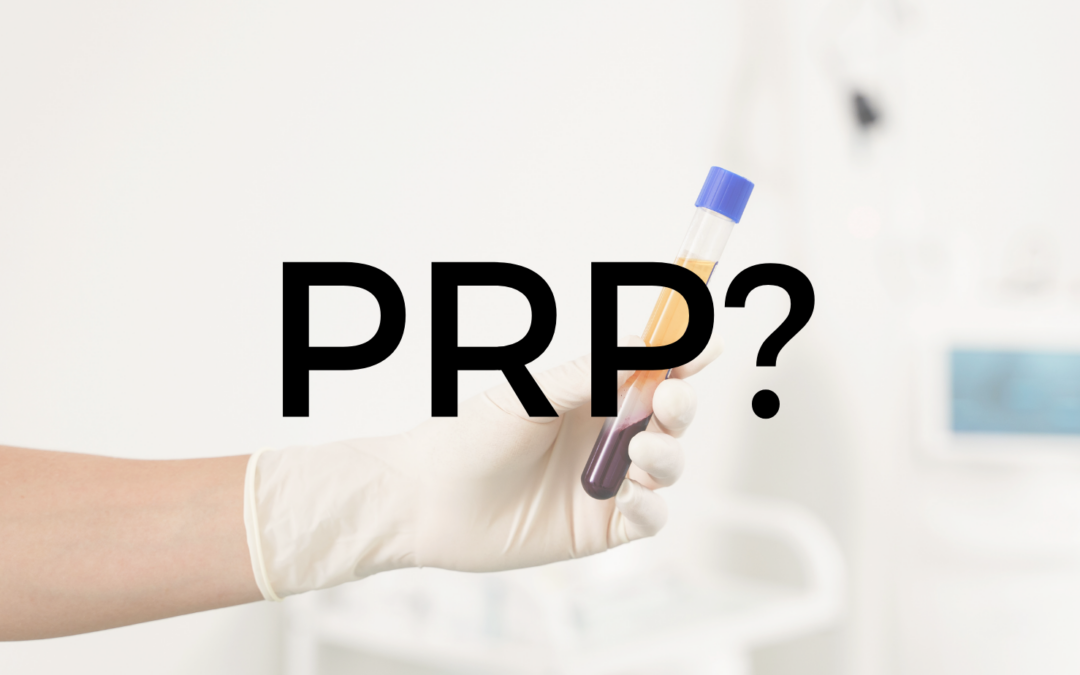What is PRP? What can PRP therapy help with? Should I consider PRP as a therapy? Platelet-rich plasma, or PRP, is known as an orthobiologic therapy that is performed by drawing blood, spinning the blood in a centrifuge, and collecting the plasma portion that has been separated to be able to be injected into problematic areas. PRP is a rapidly growing therapy in orthopedic and sports medicine to aid in the recovery and healing process to limit the build-up of scar tissue and promote optimal healing. PRP is a special therapy because the therapy is derived from a patient’s blood not farmed from umbilical cord blood, nor is it chemically driven like steroid injections. This approach also minimizes the chance of infection following a PRP injection because the blood product is the patient’s own. The power of PRP comes from the growth factors that are inherent in the platelets themselves. When the body goes into a healing response due to injury or trauma a whole host of cells infiltrate the damaged area to immediately start the healing process. Platelets arrive at the damaged area(s) and are activated to begin the process of healing. When the platelets are activated they release specific growth factors that aid in very specific tissue regeneration. Specific cells called macrophages help to remove damaged tissue and debris from the area in addition to secreting cytokines which are signaling proteins for activating the inflammatory response and fibroblast cells to promote collagen synthesis to start the repair. These signaling proteins and fibroblasts work together with platelets in the repair of the damaged tissue. As the platelets continue to release these growth factors the tissue has a blueprint of how to correctly repair the damaged area(s). The use of PRP is a markedly big advance when it comes to treating injuries because of the inherent healing capabilities of platelets. By injecting PRP into damaged tissue the body has an overload of cells that promote optimal healing.
Because platelets have the proficiency in aiding healing and play a big role in inflammation it is only natural that PRP can be used for a wide range of injuries and conditions. The list of injuries and conditions that PRP can treat is long and the ones mentioned are not an all-encompassing list. Conditions such as osteoarthritis, degenerative joint disease, tendinosis, rheumatoid arthritis, hip impingement, frozen shoulder, rotator cuff tears, patellofemoral pain syndrome, post-surgical pain, ligament sprains, and muscle strains. PRP can be helpful for those who have an acute injury such as a ligament sprain or rotator cuff tear. PRP can also be helpful for those who have had chronic conditions such as osteoarthritis or tendinosis. As stated before PRP can help treat a wide range of musculoskeletal conditions. These kinds of conditions can be from a lifetime of overuse and repetitive trauma. Others are acute injuries that stem from people who play sports or from accidents.
PRP can be used to treat these conditions, even in car accidents. Motor vehicle accidents can account for many of these conditions and more. The spine is also susceptible to injury in car crashes because of its innate structure. Ligaments and muscles surround the spine helping to keep it stable yet mobile. The discs that sit between each vertebra can be damaged as well from the shearing forces that are placed upon them during an auto accident. The spine is not the only part of the body that can be injured from these shearing forces which is why PRP is helpful in car accident situations because of the types of injuries that can occur. This isn’t to say that car accident injuries can only be fixed by PRP but PRP can be another therapy when discussing treatment after an auto accident.
PRP can be considered for almost all people who suffer from the aforementioned conditions but there are some who may not qualify for PRP therapy. Those who have had a recent illness or fever, those who have chronic anemia, patients on blood thinners and patients who have been diagnosed with cancer, specifically blood or bone cancers.
Patients should consider PRP for any musculoskeletal condition, especially those who have had chronic pain for years. Acute injuries can be helped with PRP but the caveat is that it does not significantly speed up the healing process, however, it can help with pain mitigation and inflammation. The result of chronic conditions is that the tissue never fully heals and can perpetuate inflammation and pain. In the presence of PRP, the body has an abundance of factors to promote optimal healing and true tissue recovery.
In addition to PRP, we include ozone and/or laser therapy to enhance the natural healing process that takes place. PRP with ozone and laser therapy is a potent combination to produce results that heal chronic and acute injuries. Ozone improves oxygen delivery to cells and immune activation of white blood cells. Both ozone and laser therapy increase all cells’ energy source called ATP. By increasing the growth factors from the platelets in the PRP and upregulating the efficiency at which cells can produce ATP through optimal oxygen delivery, damaged tissue and injuries don’t stand a chance and there is a lower possibility of scar tissue and fibrosis at the healing site.
We strive to treat our patients to the best of our ability with the best therapies. By integrating these therapies patients can rest assured that they are getting the best care possible in our office. In consultation with any of our doctors, they will determine what therapies would be best suited for any condition or injury you might have. The beauty of going through an exam and consultation is that we can best serve our patients with optimal therapies without sacrificing integrity and getting the best results possible.
Get Started with PRP Therapy at Dixie Chiro Today!


Recent Comments